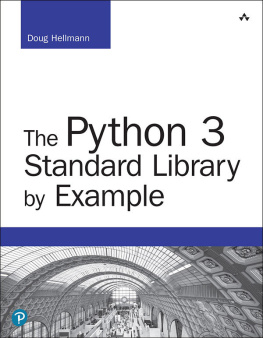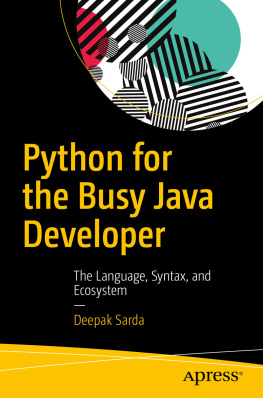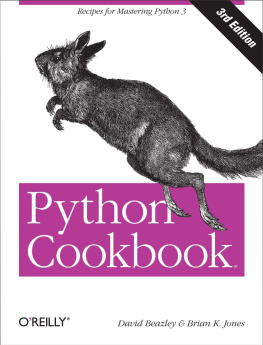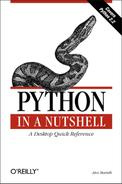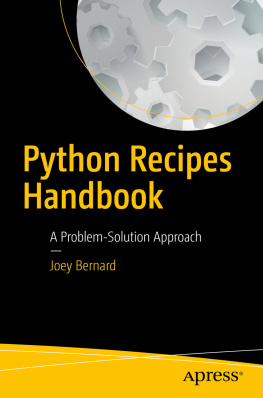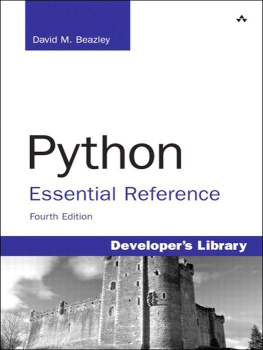About This E-Book
EPUB is an open, industry-standard format for e-books. However, support for EPUB and its many features varies across reading devices and applications. Use your device or app settings to customize the presentation to your liking. Settings that you can customize often include font, font size, single or double column, landscape or portrait mode, and figures that you can click or tap to enlarge. For additional information about the settings and features on your reading device or app, visit the device manufacturers Web site.
Many titles include programming code or configuration examples. To optimize the presentation of these elements, view the e-book in single-column, landscape mode and adjust the font size to the smallest setting. In addition to presenting code and configurations in the reflowable text format, we have included images of the code that mimic the presentation found in the print book; therefore, where the reflowable format may compromise the presentation of the code listing, you will see a Click here to view code image link. Click the link to view the print-fidelity code image. To return to the previous page viewed, click the Back button on your device or app.
The Python 3 Standard Library by Example
Doug Hellmann

Boston Columbus Indianapolis New York San Francisco Amsterdam Cape Town
Dubai London Madrid Milan Munich Paris Montreal Toronto Delhi Mexico City
So Paulo Sydney Hong Kong Seoul Singapore Taipei Tokyo
Many of the designations used by manufacturers and sellers to distinguish their products are claimed as trademarks. Where those designations appear in this book, and the publisher was aware of a trademark claim, the designations have been printed with initial capital letters or in all capitals.
The author and publisher have taken care in the preparation of this book, but make no expressed or implied warranty of any kind and assume no responsibility for errors or omissions. No liability is assumed for incidental or consequential damages in connection with or arising out of the use of the information or programs contained herein.
For information about buying this title in bulk quantities, or for special sales opportunities (which may include electronic versions; custom cover designs; and content particular to your business, training goals, marketing focus, or branding interests), please contact our corporate sales department at corpsales@pearsoned.com or (800) 382-3419.
For government sales inquiries, please contact governmentsales@pearsoned.com.
For questions about sales outside the U.S., please contact intlcs@pearson.com.
Visit us on the Web: informit.com/aw
Library of Congress Control Number: 2017932317
Copyright 2017 Pearson Education, Inc.
All rights reserved. Printed in the United States of America. This publication is protected by copyright, and permission must be obtained from the publisher prior to any prohibited reproduction, storage in a retrieval system, or transmission in any form or by any means, electronic, mechanical, photocopying, recording, or likewise. For information regarding permissions, request forms and the appropriate contacts within the Pearson Education Global Rights & Permissions Department, please visit www.pearsoned.com/permissions/.
ISBN-13: 978-0-13-429105-5
ISBN-10: 0-13-429105-0
1 17
For Theresa, my one true love.
Contents at a Glance
Contents
Introduction
Distributed with every copy of Python, the standard library contains hundreds of modules that provide tools for interacting with the operating system, interpreter, and Internetall of them tested and ready to be used to jump-start the development of your applications. This book presents selected examples demonstrating how to use the most commonly used features of the modules that support Pythons batteries included slogan, taken from the popular Python Module of the Week (PyMOTW) blog series.
This Books Target Audience
The audience for this book consists of intermediate-level Python programmers. Thus, although all of the source code is presented with discussion, only a few cases include line-by-line explanations. Every section focuses on the features of the modules, illustrated by the source code and output from fully independent example programs. Each feature is presented as concisely as possible, so the reader can focus on the module or function being demonstrated without being distracted by the supporting code.
An experienced programmer who is familiar with other languages may be able to learn Python from this book, but the text is not intended to be an introduction to the language. Some prior experience writing Python programs will be useful when studying the examples.
Several sections, such as the description of network programming with sockets or hmac encryption, require domain-specific knowledge. The basic information needed to explain the examples is included here, but the range of topics covered by the modules in the standard library makes it impossible to cover every topic comprehensively in a single volume. The discussion of each module is followed by a list of suggested sources for more information and further reading, including online resources, RFC standards documents, and related books.
Python 3 Versus 2
The Python community is currently undergoing a transition from Python version 2 to Python version 3. As the major version number change implies, there are many incompatibilities between Python 2 and 3, and not just in the language. Quite a few of the standard library modules have been renamed or otherwise reorganized in Python 3.
The Python development community recognized that those incompatibilities would require an extended transition period, while the ecosystem of Python libraries and tools was updated to work with Python 3. Although many projects still rely on Python 2, it is
only receiving security updates and is scheduled to be completely deprecated by 2020. All new-feature work is happening in the Python 3 releases.
It can be challenging, though not impossible, to write programs that work with both versions. Doing so often requires examining the version of Python under which a program is running and using different module names for imports or different arguments to classes or functions. A variety of tools, available outside of the standard library, can simplify this process. To keep the examples in this book as concise as possible, while still relying only on the standard library, they are focused on Python 3. All of the examples have been tested under Python 3.5 (the current release of the 3.x series at the time they were written), and may not work with Python 2 without modification. For examples designed to work with Python 2, refer to the Python 2 edition of the book, called The Python Standard Library by Example.
In an effort to maintain clear and concise descriptions for each example, the differences between Python 2 and 3 are not highlighted in each chapter. The Porting Notes appendix summarizes some of the biggest differences between these versions, and is organized to be useful as an aid when porting from Python 2 to 3.
How This Book Is Organized
This book supplements the comprehensive reference guide (available at http://docs.python.org), providing fully functional example programs to demonstrate the features described there. The modules are grouped into chapters to make it easy to find an individual module for reference and browse by subject for more leisurely exploration. In the unlikely event that you want to read it through from cover to cover, it is organized to minimize forward references to modules not yet covered, although it was not possible to eliminate them entirely.

